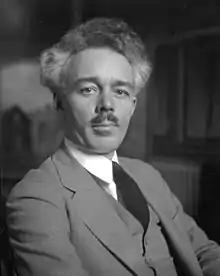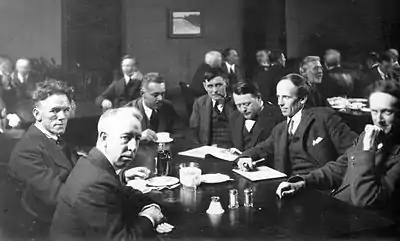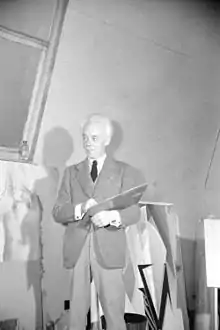Lawren Harris
Lawren Stewart Harris CC (October 23, 1885 – January 29, 1970) was a Canadian painter. He was born in Brantford, Ontario, and is best known as a member of the Group of Seven who pioneered a distinctly Canadian painting style in the early twentieth century. A. Y. Jackson has been quoted as saying that Harris provided the stimulus for the Group of Seven. During the 1920s, Harris' works became more abstract and simplified, especially his stark landscapes of the Canadian north and Arctic. He also stopped signing and dating his works so that people would judge his works on their own merit and not by the artist or when they were painted. In 1969, he was made a Companion of the Order of Canada.
Lawren Harris | |
|---|---|
 Harris in 1926, photographed by M. O. Hammond | |
| Born | Lawren Stewart Harris October 23, 1885 |
| Died | January 29, 1970 (aged 84) Vancouver, British Columbia, Canada |
| Resting place | Kleinburg, Ontario, Canada |
Notable work | North Shore, Lake Superior, 1926 |
| Movement | Group of Seven |
Life
Early years
Lawren Stewart Harris was born on October 23, 1885 in Brantford, Ontario. The son of Thomas Morgan Harris and Anna Stewart, Harris was an heir to the Massey-Harris fortune.[1][2] The wealth and status of the family afforded Harris a privileged youth, which allowed him to focus on his painting career.[3] He attended Central Technical School and St. Andrew's College. From 1904 to 1908 he studied in Berlin. He was interested in philosophy and Eastern thought. Later, he became involved in Theosophy and joined the Toronto Lodge of the International Theosophical Society. Harris went on to marry Beatrice (Trixie) Phillips on January 20, 1910, and together had three children (Lawren P. Harris, Margaret Anne Harris, Howard K. Harris) born in the first decade of their marriage. Soon after meeting and becoming friends with J. E. H. MacDonald in 1911, they together formed the famous Group of Seven. He financed the construction of a studio building in Toronto with friend James MacCallum. The studio provided artists with cheap or free space where they worked.
Career


In 1918 and 1919, Harris financed boxcar trips for the artists of the Group of Seven to the Algoma region, travelling along the Algoma Central Railway and painting in areas such as the Montreal River and Agawa Canyon. In the fall of 1921, Harris ventured beyond Algoma to Lake Superior's North Shore, where he would return annually for the next seven years. While his Algoma and urban paintings of the late 1910s and early 1920s were characterized by rich, bright colours and decorative composition motifs, the discovery of Lake Superior subject material catalyzed a transition to a more austere, simplified style, with limited palettes - often jewel colours with a range of neutral tones. In 1924, a sketching trip with A.Y. Jackson to Jasper National Park in the Canadian Rockies marked the beginning of Harris' mountain subjects, which he continued to explore with annual sketching trips until 1929, exploring areas around Banff National Park, Yoho National Park and Mount Robson Provincial Park. In 1930, Harris went on his last extended sketching trip, travelling to the Arctic aboard the supply ship SS. Beothic for two months, during which time he completed over 50 sketches. The resulting Arctic canvases that he developed from the oil panels marked the end of his landscape period, and from 1935 on, Harris enthusiastically embraced abstract painting. After the disbanding of the Group of Seven in 1933, Harris and the other surviving members including A. J. Casson, Arthur Lismer, A. Y. Jackson, and Franklin Carmichael, were instrumental in forming its successor, the larger national group, the Canadian Group of Painters.
Personal life
On January 20, 1910, Harris married Beatrice (Trixie) Phillips. The couple had three children. Harris later fell in love with Bess, the wife of his school-time friend, F.B. Housser. Harris and Bess fell in love, but saw no way forward. For the two to divorce their spouses and marry would cause an outrage.
Harris eventually left his wife of 24 years, Trixie, and his three children, and married Bess Housser in 1934. He was threatened with charges of bigamy by Trixie’s family because of his actions. Later that year he and Bess left their home and moved to the United States. In 1940 they moved to Vancouver, British Columbia. Bess died in 1969.
Death
Harris died in Vancouver in 1970, at the age of 84, as a well-known artist. He was buried on the grounds of the McMichael Canadian Art Collection, where his work is now held.
Media
In 2016 a film about Harris's life, Where the Universe Sings, was produced by TV Ontario. It was created by filmmaker Peter Raymont and directed by Nancy Lang.[4]
Record sale prices
In 1981, South Shore, Baffin Island was sold for $240,000, a record price for a Canadian painting.[5] On May 29, 2001, Harris's Baffin Island painting was sold for a record of $2.2 million (record up to that time).[6] Before the auction, experts predicted the painting done by one of the original Group of Seven would top $1 million, but no one expected it to fetch more than twice that amount. The painting, which has always been in private hands, depicts icy white mountains with a dramatic blue sky. In 2005, Harris's painting, Algoma Hill, was sold at a Sotheby's auction for $1.38 million. It had been stored in a backroom closet of a Toronto hospital for years and was almost forgotten about until cleaning staff found it.[7]
On May 23, 2007, Pine Tree and Red House, Winter, City Painting II by Harris came up for auction by Heffel Gallery in Vancouver, BC. The painting was a stunning canvas from 1924 that was estimated to sell between $800,000 and $1,200,000. The painting sold for a record-breaking $2,875,000 (premium included). On November 24, 2008, Harris's Nerke, Greenland painting sold at a Toronto auction for $2 million (four times the pre-sale estimate).[8]
On November 26, 2009, Harris's oil sketch, The Old Stump, sold for $3.51 million at an auction in Toronto.[9] In May 2010, Harris's painting, Bylot Island I, sold for $2.8 million at a Heffel Gallery auction in Vancouver, British Columbia.[10] On November 26, 2015, his painting Mountain and Glacier was auctioned for $3.9 million at a Heffel Fine Art Auction House auction in Toronto, breaking the previous record for the sale of one of Harris's works. Another piece, Winter Landscape, sold for a hammer price of $3.1 million in the same auction.[11] On November 23, 2016, Mountain Forms sold for $11.2 million.[12]
See also
- The Studio Building
- The Indian Church
- Alexandra Biriukova, architect who designed his residence
References
- "Lawren Harris (1885-1910)" (PDF). Ontario Heritage Trust. Retrieved 27 November 2016.
- Murray, Joan. "Lawren Harris". The Canadian Encyclopedia. Historica Canada. Retrieved 27 November 2016.
- "Lawren S. Harris (1885-1970)". www.mcmichael.com. McMichael Canadian Art Collection. Retrieved 27 November 2016.
- "Lawren Harris film captures acclaimed painter’s life and times". Toronto Star, Lauren La Rose, June 25, 2016
- chronicle of Canada, (Montreal, 1990) Chronicle Publications, at pp.858 -859.
- ""Baffin Island" painting sold for record $2.2 million". CBC News. 30 May 2001. Retrieved 27 November 2016.
- Lawren Harris painting sells for $1.38 million, CTV.ca, retrieved on May 16, 2007.
- Group of Seven founder's art worth $1M Archived 2012-11-08 at the Wayback Machine, Canwest News Service, retrieved on November 25, 2008.
- "Group of Seven sketch draws $3.5M | CBC News".
- Dhillon, Sunny (27 May 2010). "Lawren Harris painting goes for $2.8 million at Heffel auction | Toronto Star". Toronto Star. Retrieved 27 November 2016.
- "Lawren Harris, Tom Thomson and Alex Colville paintings smash records at auction". CBC News. November 26, 2015. Retrieved November 27, 2015.
- Wheeler, Brad (24 November 2016). "Lawren Harris 'Mountain Forms' painting sells for record $11.2-million". The Globe and Mail. Retrieved 24 November 2016.
Further reading
Primary sources
- Harris, Lawren (1922). Contrasts: A Book of Verse. Toronto: McClelland & Stewart.
- ——— (July 1926). "The Revelation of Art in Canada". Canadian Theosophist. 7: 85–88.
- ——— (May 1927). "Modern Art and Aesthetic Reactions: An Appreciation". Canadian Forum. 7: 239–41.
- ——— (1929). "Creative Art and Canada". In Brooker, Bertram (ed.). Yearbook of the Arts in Canada, 1928-29. Toronto: Macmillan. pp. 177–86.
- ——— (15 July 1933). "Theosophy and Art". Canadian Theosophist. 14 (5): 129–32.
- ——— (15 Aug 1933). "Theosophy and Art". Canadian Theosophist. 14 (6): 161–6.
- ——— (Dec 1933). "Different Idioms in Creative Art". Canadian Comment. 2 (12): 5–6, 32.
- ——— (October 1943). "The Function of Art". Art Gallery Bulletin [Vancouver Art Gallery]. 2: 2–3.
- ——— (1948). "The Group of Seven in Canadian History". Canadian Historical Association: Report of the Annual Meeting held at Victoria and Vancouver, 16-19 June 1948. Toronto: University of Toronto Press. pp. 28–38.
- ——— (Jan 1949). "An Essay on Abstract Painting". Royal Architectural Institute of Canada Journal. 26 (1): 3–8.
- ——— (1954). Abstract Painting: A Disquisition. Toronto: Rous and Mann Press.
- ——— (1964). The Story of the Group of Seven. Toronto: Rous and Mann Press.
Secondary sources
- Adamson, Jeremy (2008). "Lawren Harris: Towards an Art of the Spiritual". The Thomson Collection at the Art Gallery of Ontario. Toronto: Skylet. pp. 67–87.
- Bell, Andrew (Christmas 1948). "Lawren Harris: A Retrospective Exhibition of His Painting, 1910-1948". Canadian Art. 6 (2): 50–3.
- Boyanoski, Christine (1989). "Charles Comfort's Lake Superior Village and the Great Lakes Exhibition". Journal of Canadian Art History. 12 (2): 174–98.
- Carr, Angela K. (1998). "Portrait of Dr. Salem Bland: Another Spiritual Journey for Lawren S. Harris?". Journal of Canadian Art History. 19 (2): 6–27.
- Christensen, Lisa (2000). A Hiker's Guide to the Rocky Mountain Art of Lawren Harris. Calgary: Fifth House.
- Duncan, Norman (1909). Going Down from Jerusalem: The Narrative of a Sentimental Traveller. New York and London: Harper and Brothers.
- Duval, Paul (2011). Where the Universe Sings. Toronto: Cerebrus.
- Fairley, Barker (June 1921). "Some Canadian Painters: Lawren Harris". Canadian Forum. 1: 275–78.
- Foss, Brian (1999). ""Snychronism" in Canada: Lawren Harris, Decorative Landscape, and Willard Huntington Wright, 1916-1917". Journal of Canadian Art History. 20 (1/2): 68–91.
- Frye, Northrop (Christmas 1948). "The Pursuit of Form". Canadian Art. 6 (2): 54–7.
- Harris, Bess; Colgrove, R. G. P., eds. (1969). Lawren Harris. Toronto: Macmillan of Canada.
- King, James (2012). Inward Journey: The Life of Lawren Harris. Toronto: Thomas Allen.
- Larisey, Peter (1982). The Landscape Painting of Lawren Stewart Harris (Ph.D. thesis). Columbia University.
- ——— (1993). Light for a Cold Land: Lawren Harris's Work and Life; An Interpretation. Toronto: Dundurn.
- ——— (1974). "Nationalist Aspects of Lawren S. Harris's Aesthetics". National Gallery of Canada Bulletin/Galerie National du Canada Bulletin. 23: 3–9.
- ——— (1974). "A Portfolio of Landscapes by Lawren S. Harris/Carton de paysages de Lawren S. Harris". National Gallery of Canada Bulletin/Galerie National du Canada Bulletin. 23: 10–16.
- Lauder, Brian (Summer 1976). "Two Radicals: Richard Maurice Bucke and Lawren Harris". Dalhousie Review. 56 (2): 307–18.
- Linsley, Robert (1996). "Landscapes in Motion: Lawren Harris and the Heterogeneous Modern Nation". Oxford Art Journal. 19 (1): 80–95. doi:10.1093/oxartj/19.1.80.
- Mandel, Eli (Oct–Nov 1978). "The Inward, Northward Journey of Lawren Harris". Artscanada. 35 (3): 17–24.
- Mergen, Bernard (1997). The Modern Minds of Winter. Washington, DC: Smithsonian Institution Press. pp. 207–46.
- Murray, Joan; Fulford, Robert (1982). The Beginning of Vision: The Drawings of Lawren S. Harris. Toronto: Douglas & McIntyre in association with Mira Godard Editions.
- Plaff, L.R. (1978). "Portraits by Lawren Harris: Salem Bland and Others". RACAR: Revue d'art canadienne / Canadian Art Review. 5 (1): 21–7.
- Reid, Dennis (Dec 1968). "Lawren Harris". Artscanada. 25 (5): 9–16.
- Robins, John (Apr–May 1944). "Lawren Harris". Canadian Review of Music and Other Arts. 2 (3/4): 13–14.
- Smith, Sydney (Feb–Mar 1942). "The Recent Abstract Work of Lawren Harris". Maritime Art. 2 (3): 79–81.
- Street, Linda Marjorie (1980). Emily Carr: Lawren Harris and Theosophy, 1927-1933 (Dissertation). Ottawa: Carleton University.
- Trainor, James (Feb 2001). "Facing North". Border Crossings. 20 (1): 61–3.
- "What B.C. Means to Nine of Its Best Artists". Maclean's. Vol. 71 no. 10. 10 May 1958. pp. 27–33.
Exhibition catalogues
- Adamson, Jeremy (1978). Lawren S. Harris: Urban Scenes and Wilderness Landscapes, 1906-1930. Toronto: Art Gallery of Ontario.
- Hunter, Andrew (2000). Lawren Stewart Harris: A Painter's Progress. New York: Americas Society.
- Jackson, Christopher (1991). Lawren Harris: North by West; The Arctic and Rocky Mountain Paintings of Lawren Harris, 1924-1931/Lawren Harris: le Grand Nord via l'Ouest: les tableaux de l'Arctique et des Rocheuses peints par Lawren Harris de 1924 à 1931. Calgary: Glenbow Museum.
- Lawren Harris, Paintings, 1910-1948. Toronto: Art Gallery of Toronto. 1948.
- Lawren Harris Retrospective Exhibition 1963. Ottawa: National Gallery of Canada. 1963.
- Lawren P. Harris, 37/72. Halifax: Dalhousie Art Gallery, Halifax. 1972.
- Martin, Steve; Burlingham, Cynthia; Hunter, Andrew; Quinn, Karen (2015). The Idea of North: The Paintings of Lawren Harris. Toronto: Art Gallery of Ontario. ISBN 978-3791354705.
- Reid, Dennis (1985). Atma Buddhi Manas: The Later Work of Lawren S. Harris. Toronto: Art Gallery of Ontario.
The Group of Seven and Canadian art
- Boulet, Roger (1982), The Canadian Earth, M. Bernard Loates, Cerebrus Publishing, ISBN 0920016103, archived from the original on 2012-12-08
- Cole, Douglas (Summer 1978). "Artists, Patrons and Public: An Inquiry into the Success of the Group of Seven". Journal of Canadian Studies. 13 (2): 69–78. doi:10.3138/jcs.13.2.69. S2CID 152198969.
- Colgate, William (1943). Canadian Art: Its Origin and Development. Toronto: Ryerson Press.
- Davis, Ann (1992). The Logic of Ecstasy: Canadian Mystical Painting, 1920-1940. Toronto: University of Toronto Press.
- Dawn, Leslie (2006). National Visions, National Blindness: Canadian Art and Identities in the 1920s. Vancouver: UBC Press.
- Dejardin, Ian, ed. (2011). Painting Canada: Tom Thomson and the Group of Seven. London: Dulwich Picture Gallery.
- Duvall, Paul (1972). Four Decades: The Canadian Group of Painters and Their Contemporaries, 1930-1970. Toronto: Clarke Irwin.
- Grace, Sherrill E. (2004). Canada and the Idea of North. Montreal: McGill-Queen's University Press.
- Harper, J. Russell (1966). Painting in Canada: A History. Toronto: University of Toronto Press.
- Hill, Charles C. (1995). The Group of Seven: Art for a Nation. Ottawa: National Gallery of Canada.
- Housser, F. B. (1926). A Canadian Art Movement: The Story of the Group of Seven. Toronto: Macmillan.
- Hubbard, R.H. (1963). The Development of Canadian Art. Ottawa: National Gallery of Canada.
- Jackson, A.Y. (1958). A Painter's Country. Toronto: Clarke Irwin.
- King, Ross (2010). Defiant Spirits: The Modernist Revolution of the Group of Seven. D & M Publishers. ISBN 978-1553658078.
- MacDonald, Thoreau (1944). The Group of Seven. Toronto: Ryerson Press.
- MacTavish, Newton (1925). The Fine Arts in Canada. Toronto: Macmillan.
- McInns, Graham C. (1950). Canadian Art. Toronto: Macmillan.
- McKay, Marylin J. (2011). Picturing the Land: Narrating Territories in Canadian Landscape Art, 1500-1950. Montreal: McGill-Queen's University Press.
- Mellen, Peter (1970). The Group of Seven. Toronto: McClelland and Stewart.
- Murray, Joan (1993), The Best of the Group of Seven, McClelland & Stewart, ISBN 0-7710-6674-0
- O'Brian, John; White, Peter, eds. (2007). Beyond Wilderness: The Group of Seven, Canadian Identity, and Contemporary Art. Montreal: McGill-Queen's University Press.
- Orford, Emily-Jane Hills (2008). The Creative Spirit: Stories of 20th Century Artists. Ottawa: Baico Publishing. ISBN 978-1-897449-18-9.
- Reid, Dennis (1970). The Group of Seven. Ottawa: The National Gallery of Canada.
- Robson, Albert H. (1932). Canadian Landscape Painters. Toronto: Ryerson Press.
- Rosenblum, Robert (1975). Modern Painting and the Northern Romantic Tradition: Friedrich to Rothko. New York: Harper & Row.
- Silcox, David P. (2011). The Group of Seven and Tom Thomson. Richmond Hill: Firefly Books. ISBN 978-1554078851.
External links
| Wikimedia Commons has media related to Lawren Harris. |
- CBC Digital Archives - The Group of Seven: Painters in the Wilderness
- McMichael Canadian Art Collection - Group of Seven - Lawren Harris
- Detailed Biography of Lawren Harris and Artworks, retrieved on May 25, 2007.
- The Canadian Encyclopedia, Lawren Stewart Harris
